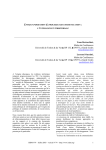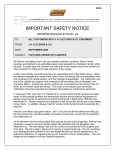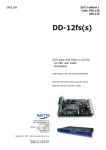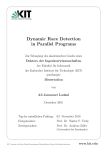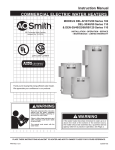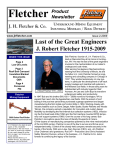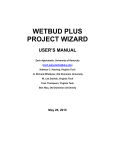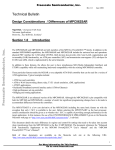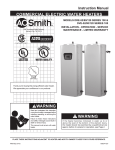Download A Novel, Web-Driven Continuous Mining
Transcript
A Novel, Web-Driven Continuous Mining Simulator By Steven J. Schafrik and Michael Karmis Department of Mining and Minerals Engineering Virginia Tech, Blacksburg, VA and Zacharias Agioutantis Department of Minerals Resources Engineering Technical University of Crete, Greece ABSTRACT The algorithms for the mathematical modeling to predict productivity of underground room-and-pillar mining systems are well known and documented. These algorithms consider the time-varying relationships between mining equipment for a given geometry of operations as well as other constraints. This paper presents WebConSim, a newly developed, Web-based, user-friendly computer simulation tool for the Windows environment. The simulator is easily customized for use by field engineers, planning engineers, and management and will help mine operators plan the optimum mining sequence for different mine geometries and equipment layouts. Program output includes production data and equipment utilization indices, as well as time driven event chains that can be used for virtual reality presentations. INTRODUCTION One of the main purposes of computer simulation is to imitate the operations of real-life systems or processes. The advantage of such simulations is that operational scenarios can be tested and evaluated without the need or use of actual experimentation. Since the early1960s, applications have been developed to simulate the space and time relationships between mining equipment, mainly in connection with transport systems (Topuz et al., 1989; Zhao and Suboleski, 1987; Ramachandran, 1983). However, for the past ten years little work has been done on modernizing the simulators by adapting them to the new computing environments available and by allowing for more complicated mining plans and extraction procedures. Zhao and Suboleski (1987) give a detailed account of the existing mine simulators at the time, including CONSIM (Topuz et al., 1989), FACESIM (Prelaz et al., 1968), and FRAPS (Haycocks et al., 1984) developed at Virginia Tech, as well as UGMHS developed at Penn State. Additionally, simulators with graphics or animation capabilities, such as MPASS-2, are also mentioned. SAM, the simulator developed by Zhao (Zhao and Suboleski, 1987) can be added to this list as well as FACEPROD, a simulator developed by Hollar (Hollar, 2000). These dedicated simulation packages were developed in general purpose programming languages such as Fortran, Pascal, and Basic. In addition to these simulation packages, programs written in general purpose simulation languages, such as GPSS, GPSS/H, Automod, and so forth (Vagenas, 1999; Sturgul, 1999), have recently been applied toward the development of discrete event simulation software packages for both underground and open-pit mining operations. OBJECTIVES AND DESIGN OF THE NEW WEBBASED SIMULATOR One of the most revolutionary advances in recent years has been the wide proliferation of the client / server architecture for collaborative software systems. The Internet and company intranets supply the connectivity for such applications. This new simulator (WebConSim) was designed to use the power of the client / server architecture, using current networking capabilities to allow access to the simulator regardless of the type of personal computer that the end user has. The actual simulator resides on the server and the users can use any kind of client to communicate their information to the server (Figure 1). Suitable clients include any Internet Explorer 3.0 compatible browser, including those running under Microsoft Windows, Unix, and Apple Macintosh operating systems, as well as browsers running on Palm Pilots. Input data are stored in a database, which also resides on the server. Therefore, a field engineer, planning engineer, mine manager, and holding company can all access the same information simultaneously. To implement this design, three separate modules were developed: the front-end module, the database module, and the simulator module. Web Browser Client Side Internet or Intranet Web Server Simulator Database Server Side Figure 1. Simulator connectivity using a client / server architecture Front End Design One of the benefits of using a Web-based front end is that a client / server architecture can be utilized, where the client communicates with the server by sending normal http requests. This is easily implemented using a technology such as Active Server Pages (ASP). ASP allows a single database to be located on a server and all Web content to be generated when the browser asks for it. ASP is compatible with all popular Internet browsers that have been made in the past five years because the browser views normal Web content and all ASP processing occurs on the server and not on the client. The other major advantage to the Web-based deployment is that a software upgrade needs to be installed only on the server location and not on the clients. The simulator module can only be hosted by a Microsoft Windows 9x or NT computer. This computer must have Microsoft ActiveX Data Objects (ADO) version 3.5 or later and Microsoft Internet Information Services version 3 or later with Active Server Pages option installed (Personal Web Server on Microsoft Windows 9X). The server must be powerful enough to accommodate all the expected concurrent connections. It is important to note that the simulator itself is not an executable application. It is an ActiveX Dynamic Link Library (DLL) that is executed from an application. There is no reason why a stand-alone executable could not be developed. This would eliminate the need for Internet Information Services and remove all the Internet connectivity from the simulator. Another important advantage of using the new ActiveX technology is that it provides for encapsulation and inheritance. Thus, changes to the simulator can be made without accessing the source code or recompiling the simulator. This includes the addition of equipment that is not accounted for at design time. Once the operational logic has been worked out, adding new equipment into the simulator can be accomplished using inheritance. Each user can, in effect, have his/her own version of the simulator that is for their specific uses instead of for general uses. Output from the system is designed to form both traditional reports and time-driven event chains. The traditional output includes cut numbers, times, and distances. The time-driven event chains can be read into animation packages and display the equipment operations in real time. This is most valuable when used in conjunction with a virtual reality viewer. The viewer can be used to spot bottlenecks that are not apparent from printed reports. Also, the viewer can be used for miner training, showing how the equipment interacts, what decisions are made, and when states change. Besides the technology that runs the front end, there is also the Web site. The Web site is designed to have maintenance and action areas. The maintenance area is how the user inputs the information into the simulator database. This area has features that automate several procedures, like equipment copy and paste functions (reducing repetitive entry). These sections are an HTML version of working with tabular datasets. The report maintenance area contains all the output from simulations that the user has not deleted. These are kept in HTML tables that allow any standard Web browser to view the reports. Through the Web site, every multiple-step process is done using a wizard. In the action section, the user can enter the cut sequence and travel paths and run the simulation. Wizards take the user through these three procedures, thus minimizing the amount of information to be entered. Depending on the number of entries and amount of equipment, the wizards can generate very large (greater than 800 x 600 pixel) displays. Almost any standard Web browser will be able to handle the large displays. The main goal of the Web site is to minimize the amount of data entered and maximize the user’s throughput. Database Design The purpose of the database in this simulator is to supply information to the simulation engine. Data are stored in a Microsoft Access 2000 database, and the simulator uses ADO to connect to the database. This allows the user to override the development platform and substitute the current implementation with a Microsoft SQL Server, an Oracle database, or any ODBC database. The goal of this abstraction is to give the user control over the data acquisition. In any case, the database connection string must be supplied to the simulator before the simulation can begin. The data stored in the database are divided into major parts: • Layouts • Cut sequences • Waypoints • Travel paths • Teams The layout information concerns only the physical dimensions of the area to be mined. These dimensions do not vary over time, depth, or length (see Table 1 for a summary). The database can include multiple layouts corresponding to different sections of a mine or different mines. Cut sequences govern the movement of the miners and roof bolters. The cut sequences are repeated between feeder moves, allowing multiple shifts to be simulated without repetitive input. Information stored in the cut sequence table includes the current mining location, the next location to be mined, as well as the tram distance in between for all cuts in a pattern. Both the miners and the roof bolters use this information (summarized in Table 1) when ready to move to the next mining location. This implementation is similar to the CONSIM implementation and allows for a very flexible mining pattern. Cut sequences may be generated automatically (using separate program modules) or keyed in manually. Table 1. Mine Information Summary Layout Cut Sequences • Entry and break widths • Floor, coal, and roof densities • Floor, coal, and roof heights • Number of entries • Cut number • Miner assigned • Roof bolter assigned • • simulator is told what team to use, it is able to get all the equipment by querying the equipment tables for the appropriate team identifier. The nature of this filter-style data storage abolishes the need to have several one-tomany relationships. These types of relationships are not available to all potential database sources and are computationally expensive. Table 2. Equipment Information Summary • Length Waypoint area • Time to begin a break cut Next waypoint area • Tram rate profile • Load rate profile • Cutting rate profile • Miner storage capacity • Initial location and state • Mean time between failures • Mean time to repair • Statistics type • Length • Bolting rate (linear ft./minute) profile, either constant or variable by entry • Tram rate profile • Initial location and state • Mean time between failures • Mean time to repair • Statistics type • Number of ways (one, two, three) • Capacity • Time to relocate • Minimum and maximum number of breaks outby face • Processing rate profile • Distance inby center line of break • Initial location and state • Mean time between failures • Mean time to repair • Statistics type The physical movements and location of all equipment are based on waypoints. A waypoint is defined as the center point at each entry / crosscut intersection. The simulator calculates the location and coordinates of each waypoint by taking the upper left corner at the maximum number of breaks inby the feeder. Then the waypoint numbers are arrayed to the right and down. They are points of travel as well as reference points for all mobile equipment. When these points are generated, the inby, outby, left, and right neighbor relationships are also calculated. Also, these points keep track of how much material is scheduled to be mined and/or has been mined in each of these directions. The same information is kept regarding the length of the bolted entry in each direction. In summary, the calculation of all physical locations of moving equipment is based on the waypoints. The waypoints are not stored in the database but are generated in each simulation run based on the layout information. Travel paths are critical to the overall effectiveness of the system. The database stores the travel paths as defined with reference to waypoints. The distance and number of turns is a property of the path. For any single to-and-from pair, there must be more than one entry in the paths section of the database, unless only one piece of equipment can travel between the two points at any given time. For instance, if a shuttle car has been loaded by a miner at waypoint 5 and would like to tram to the feeder located at waypoint 14, it must look for an available path entry from 5 to 14. Then the simulator calculates the amount of time to make the journey. Teams are mining crews and may include any combination of mining equipment. This section of the database is the most complicated, and its design is based on the FACEPROD interface. The design is intended to reduce the query time and complexity, while allowing information to be easily duplicated while the user is compiling a team. This is accomplished within one table. The team’s table stores only two pieces of information, a team identifier and a name. Each equipment type that is handled by WebConSim has a table in the database. This table stores a variety of information, as summarized in Table 2. What is most important in the actual information stored is the team identifier. This way, when the Miner Roof Bolter Feeder breaker Table 2. Equipment Information Summary Shuttle Car makes it truly event driven. Every equipment unit keeps its own Time to Next Event (TNE), the time to complete the current task and reevaluate its state. The simulation engine is interested in three things: • Capacity • Length • Switch in and out times • the original state of the equipment, • Turnaround time • the final location of the equipment, and • Tram rate unloaded and loaded profiles • • Discharge rate profile • Turning rate profile • Initial location and state • Mean time between failures • Mean time to repair • Statistics type Storage of teams in this manner increases the ease of copying equipment from one team to another. The front end allows this functionality very easily. It also allows a new team member to be based on an existing equipment piece or template. Entire teams can also be copied quickly because of the speed of accessing all the team information. In addition, Table 2 shows that there are many pieces of information that are not unique to a specific piece of equipment (e.g., mean time between failures, mean time to repair, statistics type, location, and initial state). These data are critical for all equipment for the simulator to operate. The statistics type can be deterministic or stochastic, as explained below, and is directly related to the rate profile of the equipment. The rate profile includes the rate’s average, standard deviation, minimum, and maximum and need store only the proper data for the chosen statistics type. Simulator Design In most of the dedicated simulators available today, the simulator is designed based on a specific scenario regarding types and operational models of equipment, as well as equipment restrictions. However, this approach limits the simulator to the scenario types for which it was created. These simulators are limited to the same basic premise: one continuous miner, one to three shuttle cars, one roof bolter, and one feeder (Zhao and Suboleski, 1987; Ramachandran, 1983; Hollar, 2000). However, this specific scenario does not keep up with current mining practices. At the same time, they do not implement collision detection between equipment that may share the same route. These limitations have forced engineers doing time and machine analysis to develop their own spreadsheets or work by hand. The new simulator does not have these limitations. This is because the design of the simulator implements an expert system engine, in which the focus is not on the scenario but on the equipment operations. This focus the capabilities of the equipment. From these three pieces of data, a complete simulation to and from any time point can be accurately done. It is important to note that the programming technology used in this new simulator was not available to previous simulator elements. More specifically, this expert system approach is implemented using equipment states. A shuttle car, miner, roof bolter, and feeder have states that they are in. While in a state, there is a time that the piece of equipment will be in that state. Its TNE is the current time plus the current operation time. Once a state has been completed, the equipment operator must decide what to do next. This decision is a function of the current state, the time in the current state, and what the next job is. Therefore, any kind of equipment can easily be added by allowing for appropriate state changes. The simulator operates as shown in Figure 2. It is important to note that the actual simulator does nothing except set a global time and find the next time to set. The setting of the global time is where the processing is actually done. When the time is set on a piece of equipment, the equipment checks whether its TNE (or time to state change) is equal to the current global time. If the times are the same, then the equipment decides what its new current state is and how long it will be in this state. Once this has been completed for all equipment, the simulator engine will “ask” each piece of equipment for its TNE, then it will calculate the minimum of these values and use that as the new global time. This allows for multiple pieces of equipment to be running different activities concurrently. The normal distribution uses the average and the standard deviation, while the exponential distribution uses the mean rate. User-defined analysis allows the user to create ranges of values based on a range of probabilities (e.g., from 0% to 25% is 3, from 26% to 75% is 5, 76% to 100% is 10). While determining the TNE, each piece of equipment will use the statistical analysis for the specific operation. For example, the tram rate is an input variable for most equipment, where the product of the tram distance and the tram rate yields the time to complete a tramming operation. The tram rate in the above relationship will be determined based on the statistics set for the specific piece of equipment. Begin simulation Increment global time Set time on all equipment Process State Changes Report Collector loop Find minimum TNE that will become the new global time The breakdown times and operating times are calculated based on the mean time between failures and mean time to repair. These are assumed to be exponentially distributed because they are interarrival times. This cannot be overridden using the current version of WebConSim. Table 3. Roof Bolter State Change Logic Done? Current State Action Bolting • Determine next place to be bolted. • If that place is still occupied by the miner, then change state to waiting. Set the TNE equal to the miner’s TNE. • If that place is still occupied by another bolter, then determine the next available place. • When a place to bolt is found, set the TNE to the product of distance and the tram rate. • Set the roof bolter state to the state before broken. • Reset TNE to account for the breakdown. • Set roof bolter state to bolting. • Calculate TNE based on the product of the amount that’s been cut and the bolting rate for this entry. • Determine next place to be bolted. • If that place is still occupied by the miner then change state to waiting. Set the TNE equal to the miner’s TNE. • If that place is still occupied by another bolter, then determine the next available place based on the cut sequence. • When a place to bolt is found, set the TNE to the product of distance to the place and tram rate. End Simulation Format Reports Figure 2. Flow of Simulation The type of simulation described is a new approach. It uses relatively new programming technologies to allow for multiple smart objects to be located in an artificially confined area. Each object decides on the optimum way to follow the plan that is set by the user, and then it executes that procedure. Simulation Logic: Simulation logic is evaluated when state changes occur. The state changes occur when the TNE for the equipment is equal to the current simulation time. The logic then will set the new state, the new TNE, and the physical changes that occur during the current state. The simulator logic regarding the equipment is shown in Table 3 through Table 6. Each equipment parameter (i.e., tramming rate, breakdown rate, etc.) can be evaluated based on statistical information available for the specific piece of equipment Thus, equipment parameters can be estimated either deterministically or stochastically. Stochastic distributions currently support the normal distribution (e.g., for tramming rates), the exponential distribution (for breakdowns and repairs), the uniform distribution, and user-defined distributions, where the user can enter a measured cumulative distribution function in a table form to be used by the simulator. The deterministic analysis uses only an average for the variable. The uniform analysis uses an upper and lower bound for the variable. Broken Tramming Waiting Table 5. Feeder State Change Logic Table 4. Shuttle Car State Change Logic Current State Tramming to Miner Action • • If the miner area is clear or the current location equals the miner’s, then change state to waiting to be loaded. Set TNE to the miner’s. Otherwise, change state to waiting to switch-in and set the TNE equal to switch-in time. Tramming to Feeder • Change state to unloading. • Set TNE equal to the product of dumping rate and the current load. Waiting to be Loaded • If the miner area is clear or we are at the miner, then change state to waiting to be loaded. Set TNE to the miner’s. Done Being Loaded Operating • Change feeder state to broken. • Calculate TNE using the feeder’s mean time to repair. • Change feeder state to operating. • Calculate TNE using the feeder’s mean time between failures. Broken Table 6. Miner State Change Logic Current State Action Cutting • Check whether the cut has been completed Otherwise, change state to waiting to switch-in and set the TNE equal to switch-in time. • • Notice this is 100% controlled by the miner. The shuttle car doesn’t ever set this state. If the cut is completed, then set state to waiting to tram and set the TNE to essentially zero. • • Set state to tramming to feeder. Look up the distance and profile of the path to find the amount of time it will take; use this for the TNE Otherwise, switch to waiting to load and set the TNE equal to essentially zero. • Set state to waiting to load. If the miner area is clear or the current location equals the miner’s, then change state to waiting to be loaded. Set TNE to the miner’s. • Otherwise, change state to waiting to switch-in and set TNE equal to the switch-in time. Done Unloading • Set state to tramming to miner. Look up the distance and profile of the path to find the amount of time it will take. Use this for the TNE. Broken • Set shuttle car state to the state before broken. • Reset TNE to account for the breakdown. • Determine whether the feeder can accept this shuttle car. • If there is not space, then set the TNE equal to the smallest TNE of all the shuttle cars that are unloading. • If the feeder can accept this shuttle car, then set the TNE equal to the current load x the dumping rate (this is worked out between the feeder and the shuttle car based on the feeder’s rate and current load) Waiting at the Feeder Action • • Waiting to Switch-in Current State Tramming Waiting to Load Waiting to Tram Broken • Set TNE equal to essentially zero. First, make sure another miner isn’t cutting in the air split. If one is, then set the TNE equal to the cutting miner’s. Otherwise, start cutting, providing there is a shuttle car that is located at the same place and waiting to be loaded. If all that is true, then compare the capacity of the shuttle car to the amount of coal left in the cut and invert the least to linear feet. Calculate the TNE by taking this value times the cutting rate. However, if there is nothing waiting and there is no load, then the miner will take a cut to load the miner (precut). Change the state to cutting. The miner looks at the cutting sequence to find where the next place to be cut is located. It also figures out what direction needs to be mined (up, left, or right). Is the destination occupied? If it is occupied, then switch to waiting to tram and set the TNE equal to the equipment in the way. If the place is empty, then get the distance to the place from the cut sequence and set the TNE equal to the tram rate x distance. • Set miner state to the state before broken. • Reset TNE to account for the breakdown The Report Collector: The report collector is the most memory-intensive operator in the system. The report collector monitors all the states of every equipment piece at all points in simulation time. When each simulation is completed, the report collector creates the report that was requested by the user. The report collector can create both traditional reports, in other words, those based on cut numbers or time period, as well as output that can be read into a virtual reality viewer. This is easily achieved because each piece of information that is collected includes the equipment that is reporting it and the state change. The report collector indexes each of these entries based on the current simulation time. The mine’s state (amount mined, etc.) and the specific equipment’s accumulators (distance traveled, amount loaded, etc.) are included in the entry. The time or cut reports are simple summary queries. The time report summarizes all the information based on the time it occurred. The cut report summarizes these data for the time between the miner’s tramming state. place for a specific cut, in either a brief or detailed format. A generalized event chain is shown in Table 8. Table 7. Verification Input Data Summary Input Variable Data Mine Physical Properties • Pillars 60' x 60' • 20' entry width and break width • Coal density of 0.042 tons/ft2 and 60" high Shuttle Cars • Two shuttle cars • Length – 28' • Capacity – 6 tons • Loaded tram rate – 300 ft/min • Unloaded tram rate – 450 ft/min • One miner • Length – 32', maximum cut depth – 19' ± 1' • Cut rate – 10 tons/min • Tram rate – 66 ft/sec • One feeder • Two-way • Load rate – 20 tons/min • One roof bolter • Length – 30' • Tram rate – 100 ft/sec • Bolting rate – 0.5 linear ft./min Miner SIMULATOR VALIDATION The WebConSim package was validated by running case studies that were originally developed for other dedicated simulators. In this respect, the example reported in the CONSIM manual (Topuz et al., 1989) was selected for validation. The input data are summarized in Table 7. These data are typical of the mining equipment available in the early1980s. All statistical information pertaining to this equipment is omitted from Table 7, to simplify the summary of the case study. For all equipment, the mean time between failures and mean time to repair is required. In addition, as noted above, the lower bound, upper bound, average, and standard deviation of the rates are required, depending on the type of statistics that are being used. Using these input variables, CONSIM reports that the first cut has an average mining rate of 2.45 tons/min and an average cycle time of 41.1 minutes (Topuz et al., 1989). WebConSim’s results are 2.3 tons/min and an average cycle time of 45 minutes. These results are close to, but do not match exactly, those produced by CONSIM. Allowing for the varying random numbers used for generating the statistics in the simulations, the most important consideration is the shuttle car paths. CONSIM has a single path for both of the shuttle cars. WebConSim’s path mechanism requires that two shuttle cars cannot use the same path at the same time. This adds to the practicality of the system but also takes more time. The addition of travel time will decrease the amount that can be mined. Note that both the cycle time and the mining rate both increased by around 9%. Validating WebConSim requires more than just examining the numerical output per cut. The user has the opportunity to examine the actual event chain that took Feeder Roof Bolter Table 8. Simulator Event Chain 1. 2. 3. 4. 5. 6. 7. 8. 9. 10. Feeder operating Roof bolter 1 bolting Miner cutting/shuttle car 1 being loaded Shuttle car 2 unloading at feeder Miner waiting to load Shuttle car 1 tramming to feeder Shuttle car 2 tramming to miner Shuttle car 2 waiting to be loaded Shuttle car 1 waiting at feeder Shuttle car 1 unloading This general sequence is repeated until the cut is completed. The miner changes to waiting to tram, follows the logic, and eventually will tram to the next cut. The roof bolter has a similar event chain when the area being bolted is complete (see Table 3). The event chain, coupled with the proximity to the CONSIM output, shows that WebConSim does simulate the environment fairly well. CONCLUSIONS WebConSim is a new type of simulator, which is not built for just a single scenario, but which can accommodate the majority of scenarios found in contemporary continuous miner sections. The simulation engine is an expert system that evaluates the system’s state when events on each system participant are completed. These decisions are based on the physical characteristics of the system at the time it is being evaluated (detailed in Table 3 through Table 6). This simulation gathers its data from a database. The data are accessible via the data-driven Web site (back end). This same information can be made available to different users that have access to the same network, which can be the Internet or a company intranet. The back end needs to be running on a desktop computer using an operating system using Microsoft's Windows 9x or Windows NT technology. The end user can be any type of computer that has access to the network and uses an Internet browser that is Microsoft Internet Explorer 3.0 compatible. WebConSim does generate similar results to existing continuous miner simulators. These results take into account information that was not taken into account in earlier simulators, and results differ less than 10%. REFERENCES Haycocks, C., Kumar, A., Unal, A., Osei-Agyemana, S., 1984, “Interactive Simulation for Room and Pillar Miners,” 18th APCOM, Institute of Mining and Metallurgy, London, England, pp. 5591-97. Hollar, P., 2000, personal communication, February 2000. Prelaz, L., Bucklen, E., Suboleski, S., Lucas, R., 1968, “Computer Applications in Underground Mining Systems,” Vol. 1, R & D Report No. 37, Office of Coal Research, Washington, D.C. Ramachandran, D., 1983, “A Simulation Model for Continuous Mining Systems,” M.S. Thesis, VPI & SU, Blacksburg, Va. Sturgul, J. R., 1999, “Discrete Mine System Simulation in the United States,” International Journal of Surface Mining, Reclamation, and Environment, Vol. 13, pp. 3741. Topuz, E., Nasuf, E., Ramachandran, D., 1989, “Consim: An Interactive Micro-computer Program for Continuous Mining Systems,” User Manual, 2nd Revision. Vagenas, N., 1999, “Applications of Discrete-Event Simulation in Canadian Mining Operations in the Nineties,” International Journal of Surface Mining, Reclamation and Environment, Vol. 13, pp. 77-78. Zhao, R., Suboleski, S., 1987, “Graphical Simulation of Continuous Miner Production Systems,” APCOM 87: Proceedings of the 12th International Symposium on the Application of Computers and Mathematics in the Mineral Industry.










